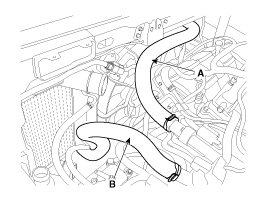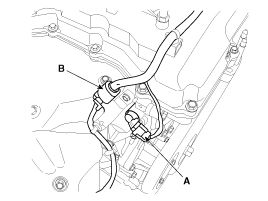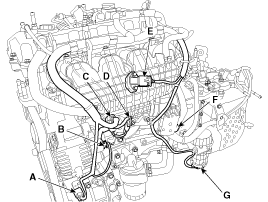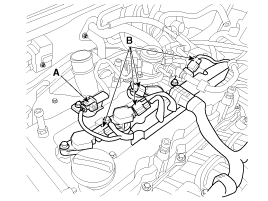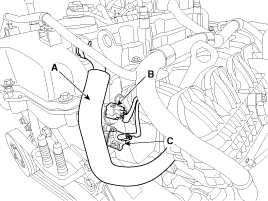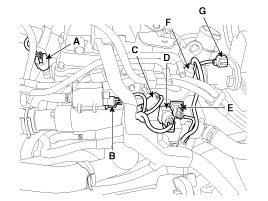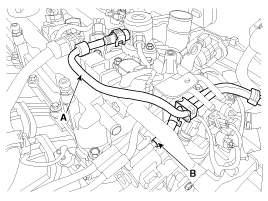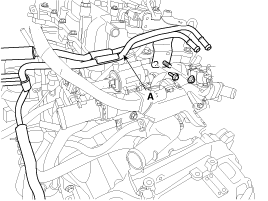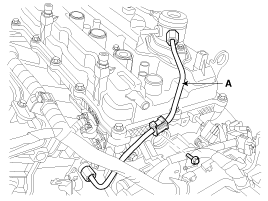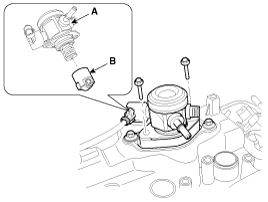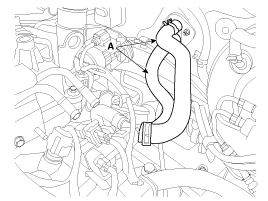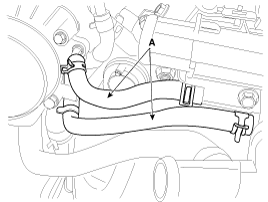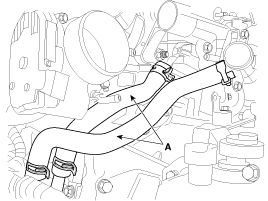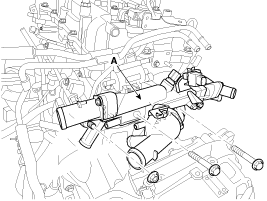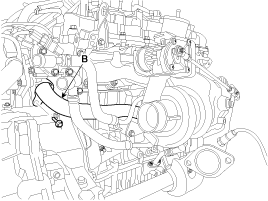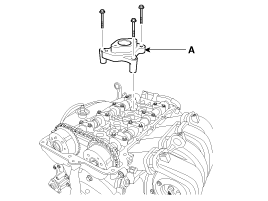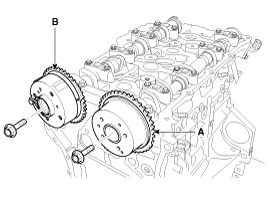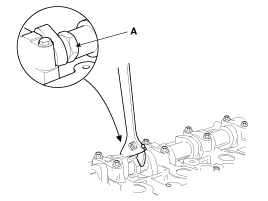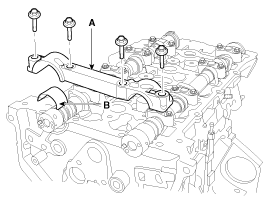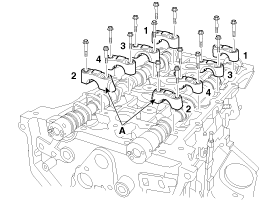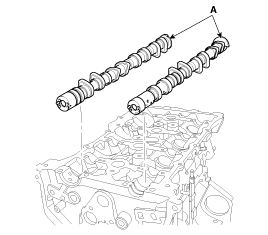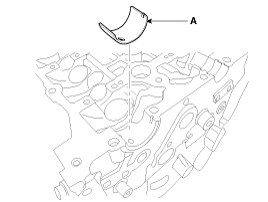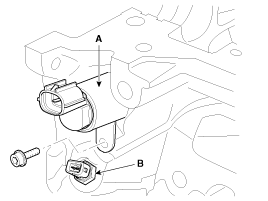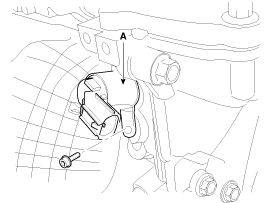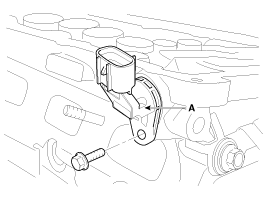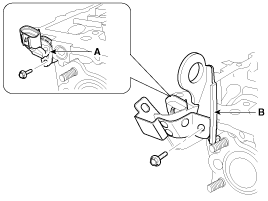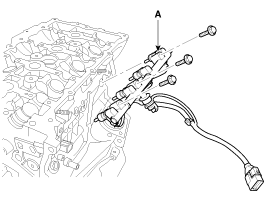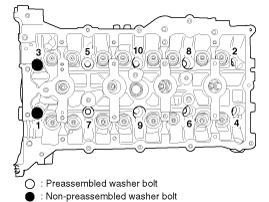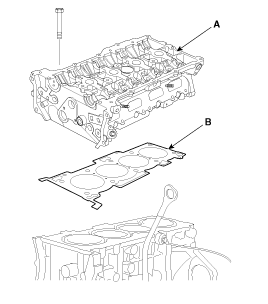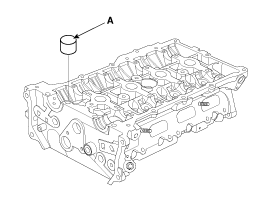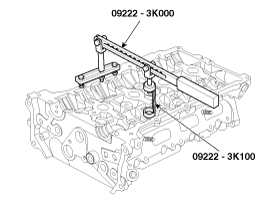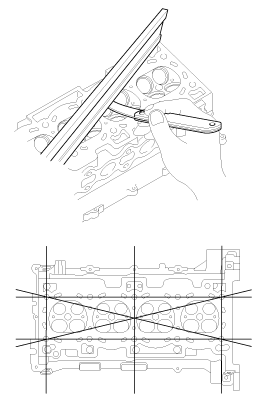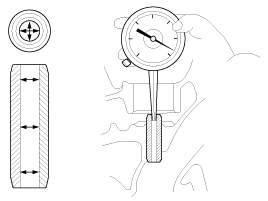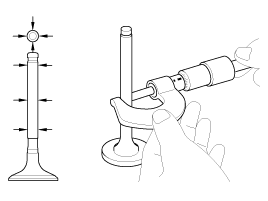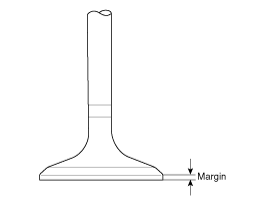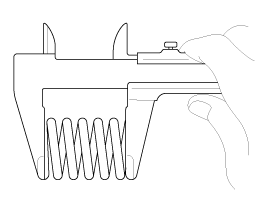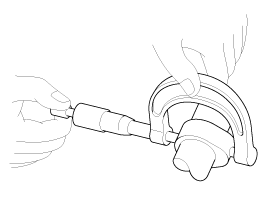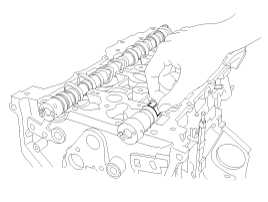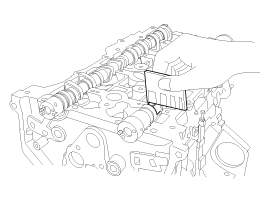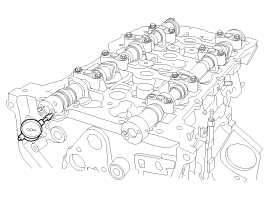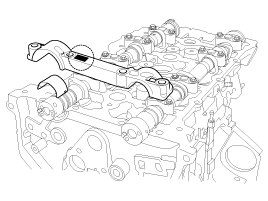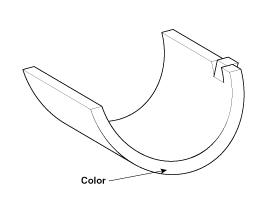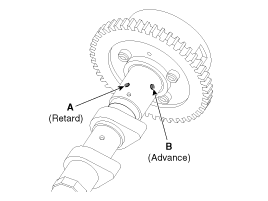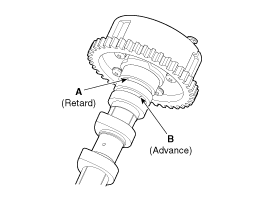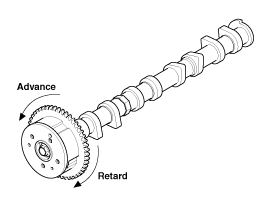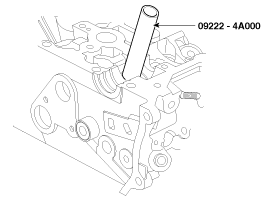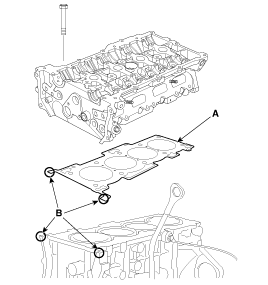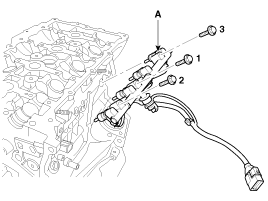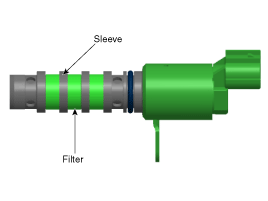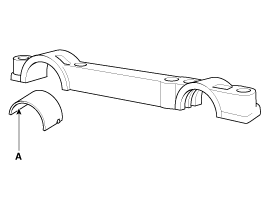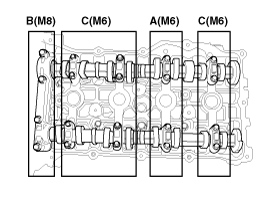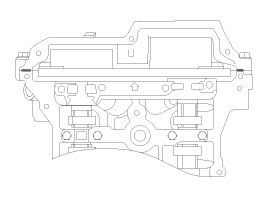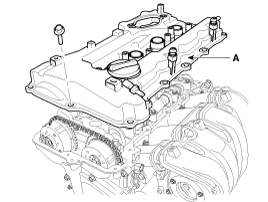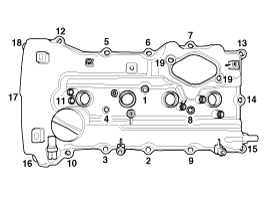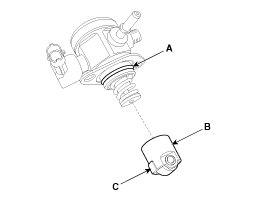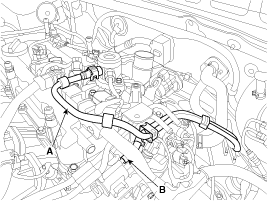 Kia Sportage: Cylinder Head: Repair procedures
Kia Sportage: Cylinder Head: Repair procedures
Third generation SL (2010–2016) / Kia Sportage SL Service & Repair Manual / Engine Mechanical System / Cylinder Head Assembly / Cylinder Head: Repair procedures
| Removal |
|
Mark all wiring and hoses to avoid misconnection. |
In case of removing the high pressure fuel pump, high
pressure fuel pipe, delivery pipe, and injector, there may be injury
caused by leakage of the high pressure fuel. So don’t do any repair
work right after engine stops. |
| 1. |
Remove the engine cover. |
| 2. |
Disconnect the battery negative terminal (A).
|
| 3. |
Remove the air cleaner assembly and the intercooler inlet/outlet hoses. (Refer to Engine and transaxle assembly in this group) |
| 4. |
Remove the RH front wheel. |
| 5. |
Remove the under cover. |
| 6. |
Loosen the drain plug, and drain the engine coolant. Remove
the radiator cap to drain with speed. (Refer to Cooling system in this
group) |
| 7. |
Disconnect the radiator upper hose (A) and lower hose (B).
|
| 8. |
Disconnect the wiring connectors and harness clamps, and
remove the wiring protectors from the cylinder head, intake manifold and
exhaust manifold.
|
| 9. |
Disconnect the fuel hose (A) and PCSV (Purge control solenoid valve) hose (B).
|
| 10. |
Remove the vacuum pipe assembly (A).
|
| 11. |
Remove the high pressure pipe (A). (Refer to FL group)
|
| 12. |
Remove the high pressure fuel pump (A) and the roller tappet (B). (Refer to FL group)
|
| 13. |
Disconnect the heater hoses (A).
|
| 14. |
Disconnect the throttle body coolant hoses (A).
|
| 15. |
Disconnect the oil cooler coolant hoses (A).
|
| 16. |
Remove the water temperature control assembly (A) with the water inlet pipe (B).
|
| 17. |
Remove the timing chain. (Refer to Timing system in this group) |
| 18. |
Remove the intake and exhaust manifold. (Refer to Intake and exhaust system in this group) |
| 19. |
Remove the high pressure fuel pump bracket (A).
|
| 20. |
Remove the intake CVVT assembly (A) and exhaust CVVT assembly (B).
|
| 21. |
Remove the camshaft.
|
| 22. |
Remove the intake OCV (Oil control valve) (A) using a torx wrench and the OTS (Oil temperature sensor) (B).
|
| 23. |
Remove the exhaust OCV (Oil control valve) (A) using a torx wrench.
|
| 24. |
Remove the intake CMPS (Camshaft position sensor) (A).
|
| 25. |
Remove the exhaust CMPS (Camshaft position sensor) (A) after removing the engine hanger (B).
|
| 26. |
Remove the injector & rail module (A). (Refer to FL group)
|
| 27. |
Remove the cylinder head.
|
| Disassembly |
Identify MLA(Mechanical Lash Adjuster), valves, valve springs
as they are removed so that each item can be reinstalled in its
original position. |
| 1. |
Remove the MLAs (A).
|
| 2. |
Remove the valves.
|
| Inspection |
Cylinder Head
| 1. |
Inspect for flatness.
Using a precision straight edge and feeler gauge, measure the
surface the contacting the cylinder block and the manifolds for
warpage.
|
| 2. |
Inspect for cracks.
Check the combustion chamber, intake ports, exhaust ports and
cylinder block surface for cracks. If cracked, replace the cylinder
head. |
Valve And Valve Spring
| 1. |
Inspect valve stems and valve guides.
|
| 2. |
Inspect the valves.
|
| 3. |
Inspect the valve seats
|
| 4. |
Inspect the valve springs.
|
MLA (Mechanical Lash Adjuster)
| 1. |
Inspect the MLA.
Using a micrometer, measure the MLA outside diameter.
|
| 2. |
Using a caliper gauge, measure MLA tappet bore inner diameter of cylinder head.
|
| 3. |
Subtract MLA outside diameter measurement from tappet bore inside diameter measurement.
|
Camshaft
| 1. |
Inspect the cam lobes.
Using a micrometer, measure the cam lobe height.
If the cam lobe height is less than standard, replace the camshaft. |
| 2. |
Inspect the camshaft journal clearance.
|
| 3. |
Inspect the camshaft end play.
|
Exhaust Camshaft Bearing
| 1. |
Check the cylinder head bore mark.
Cylinder Head Bore Identification Mark
Cylinder Head Specifications
|
| 2. |
Select class of camshaft bearing same as class of cylinder head as shown on the table below.
Exhaust Camshaft Bearing Identification Mark
Exhaust Camshaft Bearing Specifications
|
Continuously variable valve timing (CVVT) Assembly
| 1. |
Inspect the CVVT for smooth rotation.
|
| Reassembly |
Thoroughly clean all parts to be assembled.
Before installing the parts, apply fresh engine oil to all sliding and rotating surfaces.
Replace oil seals with new ones. |
| 1. |
Install valves.
|
| 2. |
Install the MLAs after appling engine oil.
Check that the MLA rotates smoothly by hand.
|
| Installation |
|
| 1. |
Install the cylinder head gasket (A) on the cylinder block.
|
| 2. |
Place the cylinder head carefully in order not to damage the gasket with the bottom part of the end. |
| 3. |
Install cylinder head bolts.
|
| 4. |
Install the injector & rail module (A). (Refer to FL group)
Pre-tighten the bolts and then tighten the bolts with the specified torque in the sequence shown.
|
| 5. |
Install the intake CMPS (Camshaft position sensor) (A).
|
| 6. |
Install the exhaust CMPS (Camshaft position sensor) (A) and the engine hanger (B).
|
| 7. |
Install the intake OCV (Oil control valve) (A) and the OTS (Oil temperature sensor) (B).
|
| 8. |
Install the exhaust OCV (Oil control valve) (A).
|
| 9. |
Install the camshafts.
|
| 10. |
Install the intake CVVT assembly (A) and exhaust CVVT assembly (B).
|
| 11. |
Install the high pressure fuel pump bracket (A).
|
| 12. |
Install the intake and exhaust manifold. (Refer to Intake and exhaust system in this group) |
| 13. |
Install the timing chain. (Refer to Timing system in this group) |
| 14. |
Check and adjust the valve clearance. (Refer to General information in this group) |
| 15. |
Install the water temperature control assembly (A) with the water inlet pipe (B).
|
| 16. |
Install cylinder head cover.
|
| 17. |
Connect the oil cooler coolant hoses (A).
|
| 18. |
Connect the throttle body coolant hoses (A).
|
| 19. |
Connect the heater hoses (A).
|
| 20. |
Install the high pressure fuel pump (A) and the roller tappet (B). (Refer to FL group)
|
| 21. |
Install the high pressure pipe (A). (Refer to FL group)
|
| 22. |
Install the vacuum pipe assembly (A).
|
| 23. |
Connect the fuel hose (A) and PCSV (Purge control solenoid valve) hose (B).
|
| 24. |
Connect the wiring connectors and harness clamps, and install
the wiring protectors to the cylinder head, intake manifold and exhaust
manifold.
|
| 25. |
Connect the radiator upper hose (A) and lower hose (B).
|
| 26. |
Install the under cover. |
| 27. |
Remove the RH front wheel. |
| 28. |
Install the intercooler inlet/outlet hoses and the air cleaner assembly. (Refer to Engine and transaxle assembly in this group) |
| 29. |
Connect the battery negative terminal (A).
|
| 30. |
Install the engine cover.
Perform the following :
|
 Cylinder Head: Components and Components Location
Cylinder Head: Components and Components Location
Components
1. Camshaft bearing cap2. Camshaft front bearing cap3. Exhaust camshaft4. Intake camshaft5. Exhaust CVVT assembly6. Intake CVVT assembly7. Exhaust camshaft upper bearing8. Exhaust cams ...
 Cylinder Block
Cylinder Block
...
Other Information:
35R Clutch Control Solenoid Valve(35R/C_VFS): Description and Operation
Description
35R Clutch control solenoid valve(35R/C) is attached to the
valve body. This variable force solenoid valve directly controls the
hydraulic pressure inside the 35R Clutch. ...
Tire specification and pressure label
The tires supplied on your new vehicle are chosen to provide the best performance
for normal driving.
The tire label located on the driver's side center pillar gives the tire pressures
reco ...
Categories
- Home
- Kia Sportage QL (2015-2019) Owners Manual
- Kia Sportage QL (2015-2019) Service Manual
- Kia Sportage SL 2010-2016 Owners Manual
- Kia Sportage SL 2010-2016 Service Manual
Copyright © www.kispmanual.com 2014-2025





